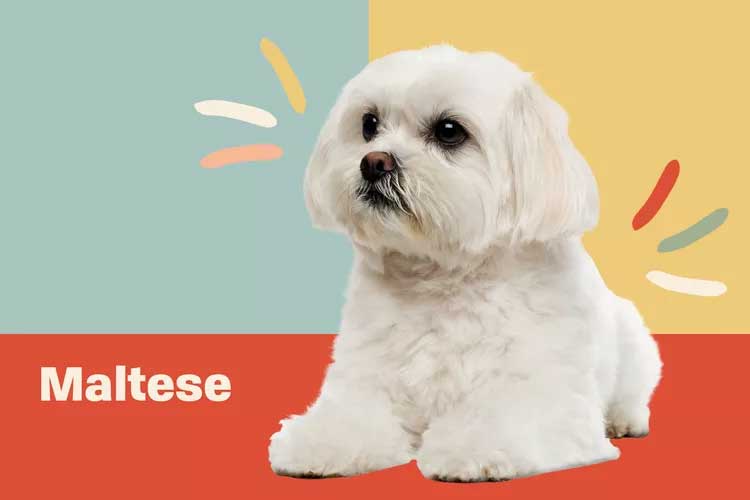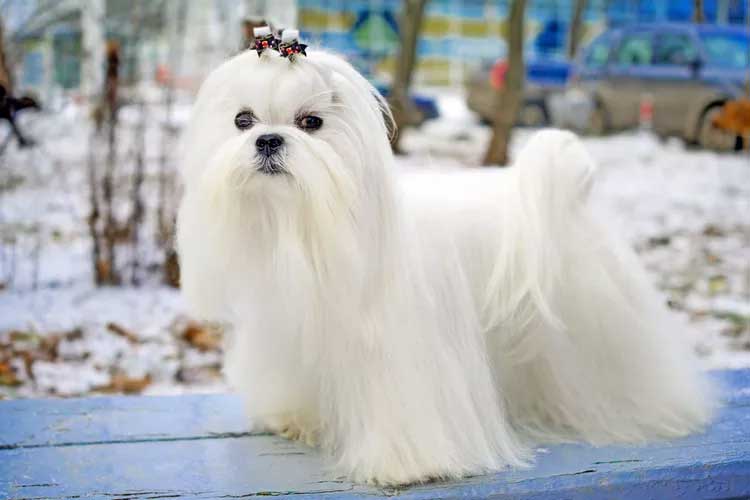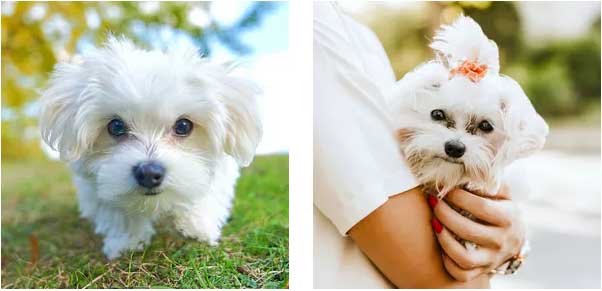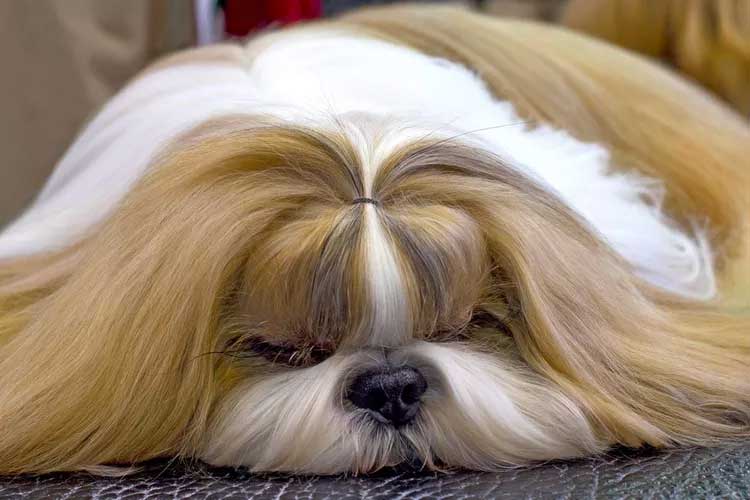While their flowing white locks draw attention, Maltese are especially beloved for their smart, gentle nature. Learn more about living with the Maltese.

Maltese Overview
| OFFICIAL NAME | Maltese |
| COMMON NAME | Maltese |
| PET HEIGHT | 7 to 9 inches |
| PET WEIGHT | 4 to 6 pounds |
| LIFESPAN | 12 to 15 years |
| GOOD WITH | cats, children, dogs, families, seniors |
| TEMPERAMENT | friendly, gentle, outgoing, playful |
| SHEDDING AMOUNT | infrequent |
| EXERCISE NEEDS | low |
| ENERGY LEVEL | active |
| VOCAL LEVEL | frequent |
| DROOL AMOUNT | low |
| BREED GROUP | toy |
| BREED SIZE | small (0-25 lbs.) |
| COAT LENGTH | long |
| COLORS | white |
| OTHER TRAITS | apartment-friendly, easy to train, good for first-time pet owners, hypoallergenic, requires lots of grooming, strong loyalty tendencies |
With her teeny-tiny stature, flowing white coat, and easy-to-train smarts, the Maltese has beauty and brains hard to beat. For that, this toy breed's been cherished since her earliest days in ancient Italy and has long been seen as a portable and charming companion.
"They were bred to be gentle-mannered, affectionate, and faithful to their owners—and that's just what they are," says Jami-Lyn Derse, DVM, founder of Veterinary Housecall Care in the Chicago area.
But don't be fooled: Though diminutive in size, the energetic Maltese dog is spunky and has a personality fit for a much larger pup. Her good looks and pleasing temperament have made her a favorite of crossbreeders, resulting in much-loved hybrid dogs such as the Maltipoo (Maltese and poodle mix), the Morkie (Maltese and Yorkshire terrier mix), the Malshi (Maltese and shih tzu mix), and the Mauxie (Maltese and dachshund mix).
Appearance
The Maltese puppy truly is the quintessential lap dog, with her fluffy white fur, adorable black-button nose, dark eyes, and sprightly demeanor. "They're like a little stuffed animal," Derse says.
The Maltese has a compact, athletic body, small floppy ears, and a tufted tail that curves over her back. By the time a Maltese reaches her full 7–9 inch height and 4–6 pound weight, those white tresses become silky smooth, requiring daily brushing along with regular baths to maintain her regal appearance.
Maltese dogs don't shed much. And while no dog is 100 percent hypoallergenic, some, like the low-shedding Maltese, may have a lower impact on allergy sufferers than other breeds.
While Maltese owners planning to show their dogs will allow them to keep their long, flowing locks, most people keeping a Maltese as a companion opt for frequent trims and short hairdos to make maintenance easier.
Temperament
Gentle, playful, smart, affectionate, trainable—Maltese lovers swear that these charming pups are among the best out there. "They're a small dog breed that has a good temperament," Derse says. "They're just playful, they're vigorous, they're cute, and they're affectionate."
Derse says Maltese are generally agreeable and can get along well with children, adults of all ages, and live well with cats and other dogs, especially when socialized early.
"For a small dog breed, I think these guys are a good option for people and families," she says. However, as with any dog, parents need to teach their children how to handle an animal and always monitor interactions, especially when both puppy and child are young.
Living Needs
A small apartment is just fine for this compact canine. While the bouncy Maltese is happy to go on walks and sprint around a fenced-in yard, she doesn't require much exercise. Rather, her most pressing need is to be near her beloved owner. And that owner, Derse says, has a tendency to spoil the dog rotten. So much so, she says, that the Maltese's feet almost never touch the ground.
"A Maltese owner often has them in a purse or has them in their lap," Derse says. "They never have them touch the floor. So when they come into the hospital, we'll put them on the floor and put a leash on them and they just have no idea what to do. That's what they're bred for—they were bred to be lap dogs."
But that doesn't mean they're lazy. In fact, Maltese excel in agility and obedience training, especially when coupled with lots of positive reinforcement.
While they can tolerate some time spent alone, they prefer to be with their family. If left alone for too long or not given enough exercise, barking can become an issue for the Maltese. Regular positive reinforcement training and plenty of attention can curb her barking tendencies.
Care
That flowing white coat requires quite a bit of grooming, Derse says. Their gorgeous fur can get matted and dirty, so daily brushing is key. Regular trims will help keep the hair from getting in their eyes, too. But even with consistent grooming, Derse says, owners shouldn't expect their Maltese to look like a show dog."If you've ever seen the [American Kennel Club] ones in the show ring, their hair is draping and flowing on the ground," she says "It's really regal-looking." But without a team of groomers on a daily retainer, the average owner will probably never get their pup to look like that.

Maltese dogs do require regular bathing and coat conditioning to keep their silky locks looking their best. And, like other breeds, you will need to maintain their fast-growing nails with regular trimming sessions, paying particular attention to not nicking the quick, as many Maltese have black toenails that make seeing that bundle of nerves more challenging. Other routine grooming—including ear cleanings and teeth brushing, which are particularly important as your dog gets older—will help with keeping your Maltese healthy between vet visits.
Tear staining is also a common—but not usually serious—problem in Maltese, resulting in a rusty tint to the hair around the dog's eyes. Talk to your veterinarian about it to make sure there are no underlying causes. Once you're sure there's no medical reason for the staining, you can reduce the appearance of stains by regularly cleaning the area and keeping her hair as dry as possible.
Health
One of the many perks of the Maltese is their long lifespan, which averages 12–15 years. As a tiny toy breed, this dog is fragile—owners must take care to not let her fall or jump from heights, or she could be injured. Both Maltese puppies and adult dogs are generally quite healthy, although, like many small breeds, they can be prone to dental problems. It's important to talk to your vet about how to care for your Maltese's pearly whites via regular teeth cleanings.In addition, knee issues such as luxated patellas can affect your Maltese, meaning the kneecap becomes weakened over time and slips out of place. Legge-Calve-Perthes Disease (LCPD) is another orthopedic concern to be aware of and affects the hips of Maltese puppies, though it is rarely seen in pups older than a year old. Maltese owners should speak with their vet about health concerns and to find out if there are preventive steps they can take to keep their pup happy and healthy for years to come.
Your Maltese breeder should conduct all health tests recommended by the OFA before selling puppies. If you're adopting your Maltese, ask the rescue for all available health information.
History
As her name states, the Maltese hails from Malta, an archipelago located below Sicily. While it's not entirely clear how the dog originated, it's known that the Greeks and Romans who occupied the area in ancient times revered the small white pooch, elevating her to status-symbol levels.Ye Ancient Dogge of Malta, as the Maltese is known in breeder circles, has been sitting in the lap of luxury for thousands of years. The Melitaie Dog has even been etched into ceramics from the Golden Age. Even Aristotle had an opinion of the Maltese, referring to the breed as "perfect in its small size." During the Dark Ages in Europe, the Maltese faced extinction when breeders cross-bred them with toy Chinese dog breeds including the shih tzu and the Pekingese.

The AKC officially recognized the breed in 1888, and the breed has risen in popularity amongst American families and dog show aficionados alike. When first shown at the Westminster Kennel Club Dog Show in 1877, the breed was billed as the Maltese lion dog. Though a Maltese has never taken the top show prize of Best in Show, these beauties have won the Toy Group multiple times.
Fun Facts
The Greeks loved this dog so much they built tombs for them, and Greek pottery that dates back to 5 A.D. is decorated with canine images that resemble the Maltese.Over time, the Maltese has accumulated a number of names and nicknames, including Maltese terrier, Roman ladies’ dog, and—perhaps the best name ever—the Maltese lion dog.
Celebrities are also fans of the Maltese. Famous owners have included Tony Bennett, Halle Berry, Marilyn Monroe, Elizabeth Taylor, and Barbra Streisand and James Brolin.
Publius, the governor of Malta in the 1st century A.D., owned a Maltese named Issa that was so popular it inspired a poem of the same name, written by Marcus Valerius Martialis, which goes like this: "Issa is more frolicsome than Catulla's sparrow. Issa is purer than a dove's kiss. Issa is gentler than a maiden. Issa is more precious than Indian gems."